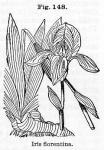
 Related entry: Iris (U. S. P.)—Iris
Related entry: Iris (U. S. P.)—Iris
The rhizome of Iris germanica, Linné; Iris florentina, Linné, and Iris pallida, Lamarck.
Nat. Ord.—Iridaceae.
COMMON NAMES: Florentine orris, Orris-root.
Botanical Source and History.—Three species of iris furnish the orris-root of commerce, the Iris germanica, or Blue flag; the Iris pallida, or Pale flag, and the Iris florentina, or White flag. The first is indigenous to south Europe, and found likewise in Morocco and northern India, and is cultivated near Florence and Lucca, besides being a common flower in London gardens. All three species have the general characteristics of the order, but differ in the color of the flower. The Iris germanica has large, handsome, dark-blue flowers. Iris pallida has flowers of a delicate, pale-blue hue. Though not indigenous, it grows plentifully about Florence and Lucca, and wild in the stony regions of Istria. Its stem is much taller than that of the I. germanica. The two preceding varieties furnish the bulk of commercial orris-root, the Iris florentina furnishing but little. The latter is closely related to Iris pallida, but has large, beautiful white flowers, marked with yellow and brown. They are sweet-scented. The rhizomes of all these species are indiscriminately collected, and are termed by the Tuscan peasants Giaggiolo. They are gathered in August, peeled, and dried by solar heat. The larger sections are replanted. The peasants divide the drug into several grades, as selected, sorts, raspings, powder, and that made into orris peas. Irisia, of the Indian bazaars, which is brought into commerce unpeeled, is believed by the authors of Pharmacographia to be the product of Iris germanica. The same source is attributed to an inferior grade from Morocco. The fresh root-stock is jointed, branching, and fleshy. Externally it is yellowish-brown, internally juicy and white. Its taste is acrid, and its odor at first earthy, becoming, as it dries, of a pleasant, violet-like fragrance, which is said to be not fully developed until the root has been dried for two years. The rhizomes of the three species all resemble each other.
Description.—Dried orris-root comes in sections from 2 to 4 inches in length, and from 1 to 1 ½ inches in width, being broadest at the apex. The pieces are made up of an elongated portion which is irregularly subconical, and sends off at its broader extremity 1, 2, and occasionally 3, branches, and these, having been cut short in trimming, give them the appearance of small cones attached to the main portion by their apices. The rhizome is somewhat bent into an arch, flattened, shrunken, grooved, and contorted. Where the small rootlets have been attached to the under surface, little circular scars may be seen. The bark is usually absent, leaving a dull, white, heavy, compact texture, which fractures irregularly. Its taste is at first bitterish and aromatic, and finally acrid; its odor suggestive of the violet. Under the microscope the drug exhibits crystals of calcium oxalate. Orris-root is sometimes adulterated with other species of orris, but they lack its peculiar fragrance. The various starches used to adulterate the powder may be detected under the lens.
Chemical Composition.—Orris-root contains a large amount of starch, a small quantity of a crystalline, volatile substance (Dumas), a brownish, soft, acrid resin, and a small proportion of tannin, which strikes green with ferric salts. By distillation with water from 0.60 to 0.80 per cent of a crystalline orris camphor floats upon the surface of the distillate. Flückiger (Pharmacographia), has proved this to be chiefly myristic acid (C14H28O2), intermingled with a small amount of volatile oil, which develops in the drying of the drug. This orris camphor, sometimes called oil of orris-root, has the persistent violet fragrance of the drug. The so-called liquid oil of orris-root is said to be prepared by digesting crushed orris-root in oil of cedar-wood, and finally distilling with steam.
Iridin (C24H26O13) is a glucosid obtained from orris-root by G. De Laire and F. Tiemann (Jahresb. der Pharm., 1893, p. 548; also see Amer. Jour. Pharm., 1894, p. 32). It must not be confused with the Eclectic Iridin (see Iris versicolor), which for half a century has been an article of commerce. It forms white needles slightly soluble in water (1 to 500), and acetone (1 to 33), insoluble in ether, chloroform, benzol, etc., soluble in hot alcohol. Dilute alcoholic sulphuric acid decomposes it, near the temperature of boiling water, into dextrose and crystallizable irigenin (C8H16O8), having the character of a phenol and producing with ferric chloride a deep violet color. Irigenin, when heated with concentrated alkali, is decomposed into formic acid, iridic acid (C10H12O5), (which is an aromatic oxy-acid), and iretol (C7H8O4), a phenol. Heated above its melting point, 180° C. (356° F.), iridic acid is decomposed into carbonic acid and a phenol, iridol (C7H5[OCH3]2OH). The synthesis of all these bodies was effected by the authors.
Action, Medical Uses, and Dosage.—Active irritant qualities are ascribed to orris-root, abdominal pain and emeto-catharsis being among its effects. These properties are dissipated upon drying the rhizome, when it becomes merely a gastric stimulant. The salivary flow and renal secretion are augmented by it while sneezing and increased pituitary secretion results from its use as a sternutatory. About the only use now made of orris-root is as an ingredient of breath perfumes and dentifrices, it not only giving a pleasant flavor, but acting beneficially on the gums. It was formerly used as a diuretic, expectorant, and remedy for chronic diarrhoea. From 5 to 15 grains constitutes a dose of the powdered root.

